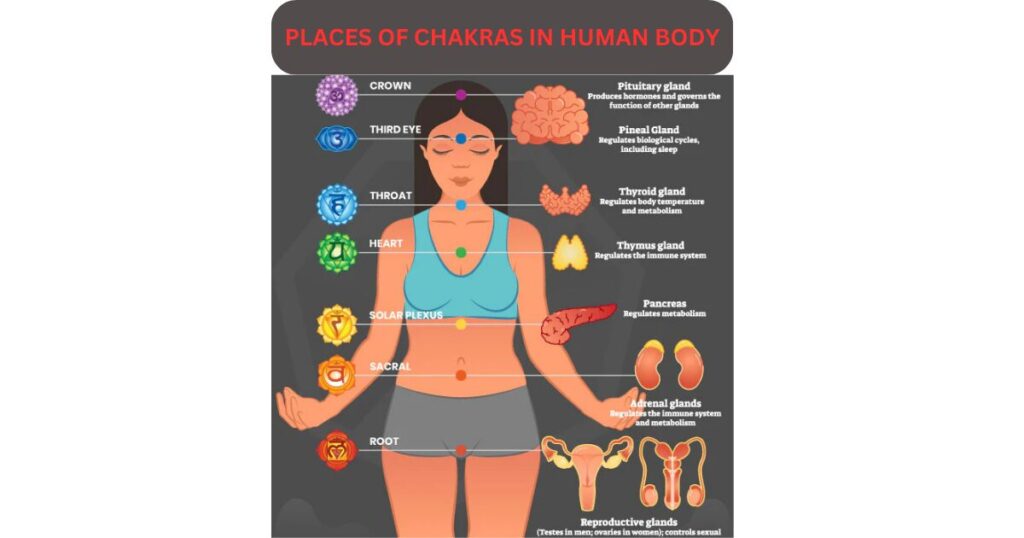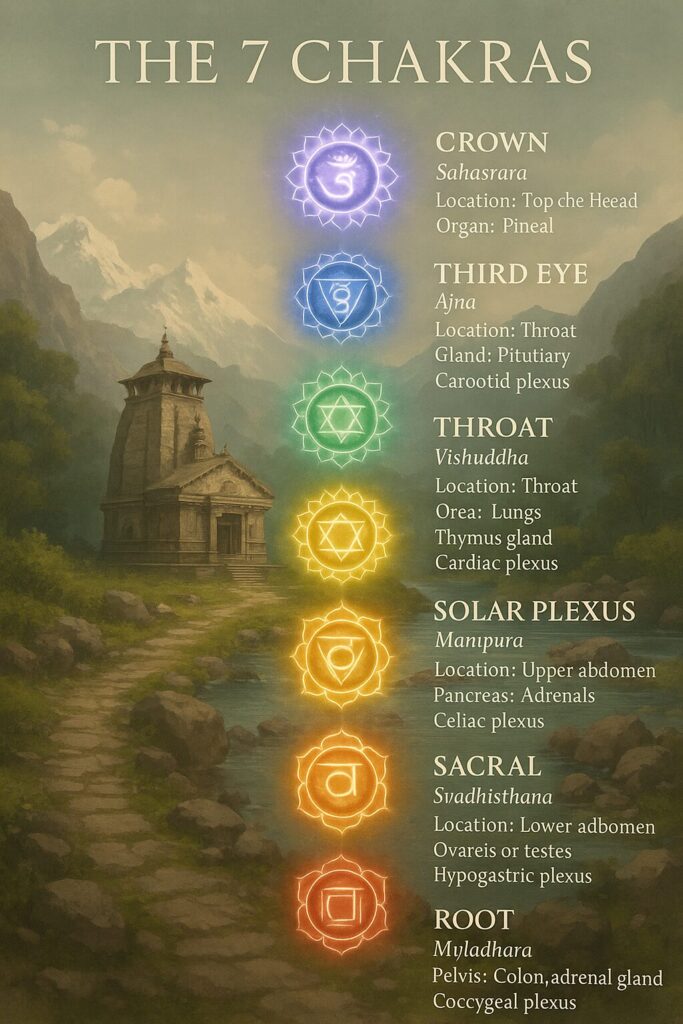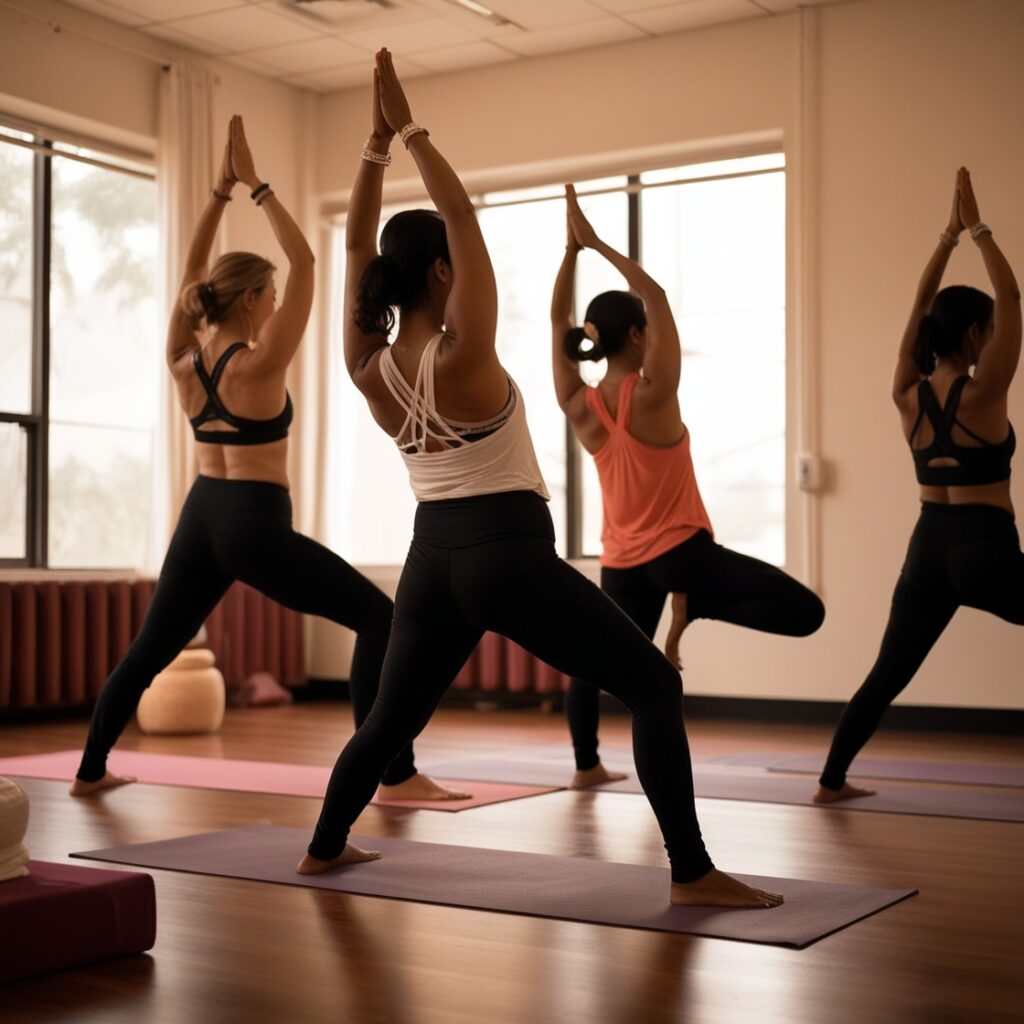“ Balance Your Life in 7 Steps with Chakra Yoga”
PREFACE: Chakra Yoga entered my life when I needed it most. At a certain point in my life, I was mentally drained, emotionally stuck, and lost physical balance, and could not identify the reason. By this time, one of my friends living at Mana (near Badrinath Temple of India, a bordering area between China and India) requested me to visit his place as a vacation trip. I felt it like a message from the Universe, a divine calling.
After a few days, I confirmed with him about my journey. My intention was only to get some relief from the hustle and bustle of this busy city and to visit Badri Nath temple, which is a serene and sacred place. I started from Dehradun in the morning and reached Joshi Math near Mana in the evening.
The entire journey through the winding Himalayan roads was nothing short of magical, with snow-kissed peaks, pine-covered valleys, and quiet streams lining the path. On our arrival at Joshi Math, my friend was waiting for me to embrace. However, after spending the night at Joshi Math, we started our journey in the morning towards Mana and Badrinath Temple. Till today, I could not think that this journey would lead me to the transformative practice of Chakra Yoga. During the entire journey, we shared our daily life and my mental, physical, and emotional condition.
After completing our worship at Badri Vishal temple, we visited Mana village and stayed at a small cottage in Mana. During the night in a dream, I saw a snow-clad Monk advising me to visit his cottage at Satopanth. I shared this divine dream with my friend, and he also confirmed the same story. After consulting our family members, we decided to visit the high-altitude trek after taking permission from all authorities and a physical check-up.
Our main motto was to meet the revered Monk. Since this was a 7-day trek, we were about to make all the preparations. By this time, another mystic monk physically visited his house, and on enquiry, we came to know that the monk visited his house only with the intention to take us to Satopanth as ordered by his revered Guru. We were quite astonished to know his intention. However, we started our journey towards his divine cottage.
We reached there within two days instead of 7 days by his grace and faced no problems during this journey. We reached Satopanth in the evening’s biting cold and darkness. A dim light peeping outside to welcome us, and we also saw that a long white bearded monk was waiting outside to embrace.
Just after our arrival at his two-room small cottage (one for his use and the other for his disciples) welcomed us by name. I was stunned to hear my name from him. This was fully mystic to me. Saw the Fire Fly lighting mesmerizing the Satopanth Lake. In the night, we completed our dinner with a glass of hot milk and slept early.
I woke up before the sunrise and enjoyed the golden light spilling over the hill tops, painting the shades in pink, orange, and gold. The cool morning mist dances between the valleys, and the birds were chirping mildly around us to welcome the day. I forgot my physical, mental, and emotional imbalance. And that was the beginning – a true awakening of my journey with Chakra yoga.
INTRODUCTION: The morning was full of spiritual vital force, attracting me towards the divinity. I bowed down to that highly enlightened spiritual monk, and before saying anything, he told me about the purpose of my visit. He also told, “I arranged everything right from your leave sanction from the office, raising your interest, and coming to this place was preplanned”.
He explained how I can come out of this cyclic bondage of my earlier life and the reasons for my present miseries. He told me to take a holy bath at Satopanth Lake. After that, I found him in a different look, like a holy monk with sandal flavors and high energetic light around his body. Automatically, I bowed down to his lotus feet.
By this time, he arranged my initiation, describing different types of Yoga postures to activate the Chakras, Mantra Chanting, and Pranayama. At the time of initiation, my revered Guruji advised me “neither to overreact nor to be demoralized. Continue with the practice of what I am teaching you. Whenever you need me, I shall come to you. Not to be afraid. Don’t disclose what I am teaching you. Obeying his advice, here, I will delve into the theoretical part only, if any of my readers wants to know more about this, he is free to contact me. I will help him to proceed, so far, I know.
The most important part of his teaching was Chakra Yoga; the other term of Chakra Yoga is Kundalini Yoga.
“Muladhare Sthito Agniḥ Svadhishthane Cha Sada Sthitaḥ |
Manipuraka-Madhyastho Maruto Hridgato’pi va ||
Anahata Bhruvor Madhye Nada-Rupo hi Sa Smṛtaḥ |
Ajna-Chakre paraṁ Jyotiḥ Sadasadvi lakṣaṇam ||”
The meaning of the above Sanskrit sloka is “The fire (Agni) is placed in the Muladhara (Root Chakra), The water element in Svadhisthana (Sacral chakra), The Air (Marut) resides in the Manipura (Solar plexus), While
the Heart (Hrid) is touched by the air’s essence. Between the eyebrows, there is Ajna chakra, the supreme light (Parama Jyotiḥ) shines — Beyond all dualities, beyond existence and non-existence.”

01. WHAT IS CHAKRA YOGA?
A special type of Yoga which can open and balance the Chakras by removing the blockages in the Nadis to increase the flow of Prana (Vital force). This is best done by Kriya Yoga and Pranayama, which is essentially the science of Chakra Activation. Chakra Yoga is designed to systematically dissolve the impurities that block the flow of energy through the Nadis. When the flow increases, the chakras are opened one by one and become optimally balanced. This helps to achieve a higher level of consciousness and awareness, which leads humans to achieve their highest potential.
02. HOW MANY CHAKRAS ARE THERE IN THE CHAKRA YOGA SYSTEM?
There are 7 (seven) chakras within a human body. These are as follows:
- Muladhara ( The Root Chakra )
- Svadhisthana ( The Sacral Chakra)
- Manipura ( The Solar Plexus Chakra )
- Anahata ( The Heart Chakra )
- Visuddha (The Throat Chakra )
- Ajna ( The Third Eye Chakra )
- Sahasrara ( The Crown Chakra )
03. PHYSIOLOGICALLY, HOW ARE THESE CHAKRAS PLACED?
- Muladhara (The Root Chakra) – It is placed at the base of the spine. The organs associated with it are Reproductive organs, the glands are the Testis for men Ovary for women, and the Spinal Nerve Plexus i.e. Coccygeal Plexus.
- Svadhisthana ( The Sacral Chakra ) – Its location is in the Sacrum. The associated organs are the Kidneys, the Urinary Bladder, the Bowel, and the Spleen. The associated gland is the Adrenal Gland. The Plexus is the Sacral Plexus.
- Manipura (The Solar Plexus Chakra) – It is placed at the Solar Plexus. Associated organs are the Stomach, Liver, and intestines. The associated gland is the Pancreas, and it is in the Spinal Nerve Plexus.
- Anahata ( The Heart Chakra ) – Its location is at the Chest. Associated organs are the Heart, Lungs, and Hands. The associated gland is the Thymus. The Plexus is Pulmonary and Cardiac.
- Visuddha ( The Throat Chakra ) – Its location is at the Throat. Associated organs are the Mouth, the Vocal cords, and the Esophagus. The Associated Gland is the Thymus, and the associated Plexus is the Pharyngeal plexus.
- Ajna (The Third Eye Chakra ) – Its location is at the middle of the eyebrows; another name is KUTASTHA. Its associated organs are the Eyes and the carotid plexus.
- Sahasrara ( Crown Chakra ) – Its location is at the middle of the head. Associated Organs are the Brain Stem and the Spinal Cord. The associated gland is the Pituitary gland, and the associated plexus is the Cerebral Cortex plexus.

04. DESCRIPTION OF VARIOUS CHAKRAS IN THE CHAKRA YOGA SYSTEM:
i. Mooladhara Chakra (The Root Chakra): In the Chakra Yoga system, we should know about the meaning, function, and benefits. Mooladhara is a Sanskrit word derived from two words (Moola – means the Root and Adhara – means the base). The Mooladhara Chakra, also known as the Root Chakra and is considered the foundation of the “chakra yoga system.” It’s located at the base of the spine in the tailbone area. This chakra is often depicted as a red lotus with four petals and is associated with the earth element.
Functionally, the Muladhara Chakra is vital for your feeling of stability and security. It’s thought to be the grounding force that allows us to connect to the earth’s energies and empower our lives. When this chakra is open and balanced, it can help a person feel confident, secure, and stable.
Awakening of Muladhara Chakra not only aims at spiritual elevation but also at the harmonization of the body, mind, and soul.
The Seed Mantra for this Chakra is “LAM.”
ii. Savisthana (The Sacral Chakra): Svasisthana is also a Sanskrit word. The meaning is (Sva or Swa means Self, and Adhisthana means established), which means where your being is established. The Svadhishthana Chakra, also known as the Sacral Chakra, is the second chakra in the chakra yoga system. It is located two finger widths above the Mooladhara Chakra, which is located in the Coccyx (tailbone), and just below the belly button in the lower abdomen. This chakra is represented by the color orange and is often depicted as a lotus with six petals. The element associated with the Svadhishthana Chakra is water, which reflects its connection to flow and flexibility in life.
Functionally, the Svadhishthana Chakra is linked to emotions, creativity, and sexuality. It governs our feelings and our ability to enjoy life, pleasure, and new experiences. When this chakra is open and balanced, it contributes a person’s feeling dynamic, stimulated, and emotionally stable. It also supports one in being open to intimacy and forming healthy relationships.
If the Svadhishthana Chakra is blocked in the Chakra Yoga system or out of balance, it can lead to issues such as emotional instability, fear of change, sexual dysfunction, and a lack of creative energy.
The seed Mantra of this Chakra is “VAM”
iii. Manipura Chakra (The Solar Plexus Chakra): It is also derived from two words from Sanskrit, Mani means gem, and Pura means City. In other words, this Mani refers to exceptional beauty and dazzling appearance gems. The Manipura Chakra is the third chakra located around the stomach area, above the navel, and below the rib cage. It is represented by the color yellow and is often depicted as a lotus with ten petals. The element associated with this chakra is fire, symbolizing its role in energy and transformation.
Functionally, the Manipura Chakra is considered the center of personal power, self-esteem, and confidence. It governs our ability to be assertive, proactive, and decisive. This chakra plays a key role in our sense of identity and the control we have over our lives. When balanced, it contributes to feelings of clarity, self-assurance, and cheerfulness. It also encourages an active and energetic approach to life.
The seed Mantra of this Chakra is “RAM.”
iv. Anahata Chakra( The Heart Chakra): Here also, the word Anahata is derived from two Sanskrit words. Ana means not, Hata means hurt. The word’s meaning is unhurt. The Anahata Chakra, also known as the Heart Chakra, is the fourth chakra located in the center of the chest, near the heart, in the Chakra Yoga system. It is represented by the color green and is often depicted as a lotus with twelve petals. The element associated with this chakra is air, which signifies its connection to openness, freedom, and the breath of life.
Functionally, the Anahata Chakra is the center of love, compassion, and kindness. It governs our relationships and how we interact with others. A balanced Anahata Chakra allows for feelings of deep connection, empathy, and emotional balance. It helps us to love and be loved in return, fostering harmonious relationships.
When the Anahata Chakra is open, a person can experience profound joy, inner peace, and a strong sense of harmony and connection to the world. If it is blocked in the Chakra Yoga system or out of balance, it can lead to feelings of loneliness, an inability to forgive, or a lack of empathy.
Focusing on the Anahata Chakra through practices like yoga, meditation, or breathing exercises can enhance one’s ability to feel emotional balance, cultivate compassion, and nurture stronger, healthier relationships. It encourages openness and connection, making it easier to give and receive love.
The seed Mantra of this Chakra is “YAM”.
v. Visuddha Chakra (The Throat Chakra): The word Vishuddhi comes from Vishuddha, meaning Pure and The Vishuddha Chakra, also known as the throat chakra, is the fifth primary chakra in the Chakra Yoga system according to Hindu and yogic traditions. It is located at the base of the throat and is associated with the color blue. This chakra is linked to communication, expression, and the ability to speak one’s truth clearly.
When the Vishuddha Chakra is open and balanced, it fosters honesty, creativity, and effective communication. Conversely, if it’s blocked in the Chakra Yoga System, it can lead to issues like shyness, insecurity, and difficulty expressing thoughts. Balancing this chakra can enhance personal and artistic expression.
The Seed Mantra of Vishuddha Chakra is “ HAM”
vi. Ajna Chakra (The Third Eye Chakra): The word Ajna is from the Sanskrit word, which means Command or perceive, and the word Chakra means the wheel that means. The Ajna Chakra, also known as the third eye chakra, is the sixth primary chakra in the human body according to Hindu and yogic traditions. Situated between the eyebrows, it is often associated with the color indigo. This chakra is considered a vital point of intuition, insight, and spiritual consciousness.
In the physical body, the Ajna Chakra is linked to the brain, eyes, and pituitary gland. It plays a significant role in the coordination of various physiological processes, from hormone regulation to the functioning of the nervous system. Mentally, it governs intuition, wisdom, and the ability to analyze and perceive truth in the world.
When the Ajna Chakra is balanced, it enhances cognitive functions, such as clarity of thought, focus, and vision. It allows individuals to access inner guidance and realize the deeper meaning of life’s events. This balance helps cultivate a deeper, more intuitive understanding of one’s spiritual journey.
Conversely, an imbalanced Ajna Chakra can lead to confusion, indecision, and an inability to think clearly or see beyond superficial appearances. Physically, it might lead to headaches, blurred vision, or eye strain. Energizing this chakra leads to improved mental clarity and spiritual awareness.
The seed Mantra of Ajna Chakra is “ SHAM”
vii. Sahasrara Chakra (The Crown Chakra): The Sahasrara Chakra, also known as the crown chakra in the Chakra Yoga system, holds a vital position in the system of chakras within the human body, according to traditional Indian beliefs rooted in yoga and meditation practices. This chakra is situated at the top of the head and is often depicted as a lotus with a thousand petals, symbolizing its connection to spiritual enlightenment and the infinite.
Historically, the concept of the Sahasrara Chakra has evolved over centuries, gaining prominence in various spiritual texts and practices. It is considered the seventh chakra in the subtle body and represents the state where individual consciousness merges with the universal consciousness. This chakra in the Chakra Yoga system is associated with the highest levels of spiritual growth, wisdom, and a deep, intrinsic understanding of the universe.
In terms of its role, the Sahasrara Chakra in the Chakra Yoga system is crucial for achieving a sense of deep peace and harmony. When fully activated, it is believed to bring about a state of liberation, known as Moksha in Hindu philosophy, where a person transcends all physical and mental limitations.
The activation of this chakra is often associated with profound spiritual experiences and enlightenment, making it a central focus in meditative practices aimed at achieving higher states of consciousness. When a Yogi reaches this state, he himself becomes God. Such types of Yogis are rarest of rare in this materialistic world. It is heard that such types of Yogis do not come back into this materialistic world. He leaves for a heavenly abode.
The seed mantra of Sahashra Chakra is “ OM”
5. HOW TO PERFORM CHAKRA YOGA?:
During my early stages, after my initiation, I was eager to be blessed with the process to awaken Mooladhara Chakra (Kundalini awakening) , but my Guruji did not agree to start right from the initial stage. When I expressed my utmost desire to learn, he told me to wait and to practice more Kriyas, since I was enunciated in Kriya Yoga. Only he told me to practice extensively MAHA MUDRA, if possible, twice a day. Then I read several books like Sadachakra Nirupana, Kundalini Upanishad, Shiva Samhita, Linga Purana, etc., to know about Chakra Yoga or Kundalini Yoga and how to achieve my target.
One day, luckily, I got a book “GHERANDA SAMHITA” which describes how to awaken Muladhara Chakra. My main purpose was to awaken the Muladhara Chakra. Noticing my keen desire, my Guruji advised me to wait, but this did not satisfy me, and my desire multiplied. I read several Upanishads and Vedas, which were written thousands of years before, to get my answer.
As per Gheranda Samhita, the simplest way of awakening Muladhar Chakra is to perform Maha Mudra extensively with Pranayam. In this process, the practitioner should sit straight on the floor with one leg stretched and the other to be kept bent so that the heel can press the perineum. When this perineum is hit repeatedly by the heel, on continuous practice, the practitioner feels a unique sensation. Then the practitioner should bend forward to hold the toe tightly without keeping the knee bent, and then raise the head slightly and focus the gaze on the KUTASTHA or the eyebrow center, perform Pranayama with awareness of the Muladhara Chakra of the energy center.
If this is performed properly with the help of a proper yoga teacher, you can achieve your goal. Another way if the practitioner close the rectum while performing Pranayam and open it further throughout the practice of Pranayam. Throughout this practice, the AUM Mantra should be repeatedly chanted within the self without making any sound (JAPA).
This can also be practiced without Pranayam while sitting idly. This practice also helps to achieve goals faster. Some of the Yoga Teachers also advise tightly wrapping the entire belly with a cloth and starting Pranayama to raise the energy from Mooladhar upward. There is another process for practicing the Chakra Yoga (Kundalini Yoga) program by learning KHECHARI MUDRA. This should not be performed without proper knowledge. Very few Yoga Teachers teach this highly concealed Yoga Kriya after they achieve a higher stage of consciousness. Therefore, my advice is to reach out to a proper Kriya Guru to get proper training. Since Kriya Yoga is very scientific, the seekers are advised to be trained by a proper Kriya Master.
6. BENEFITS AND POTENTIAL DANGERS OF CHAKRA YOGA:
Chakra yoga is the process of transforming energy from physical energy to subtle energy. This transformative experience is rooted in ancient Indian traditions, often associated with yoga and spiritual practices. This event is believed to occur when the dormant energy at the base (Mooladhar Chakra) of the spine is activated, rising through the chakras (energy centers) to the crown of the head. It is considered by many as a powerful personal and mystical experience, but it is also surrounded by discussions of both its benefits and potential dangers.
BENEFITS:
- Spiritual Insight:
Chakra Yoga is often described as the process of profound spiritual enlightenment. The practitioner, or Yogi, usually feels a deeper connection with the universe, a better understanding of its purpose, and a deep awakening to the nature of reality.
- Increased mindfulness and creativity:
Chakra Yoga or Kundalini awakening or Kundalini yoga, often leads to increased mindfulness and creativity. As the dormant energy rises through the body, individuals may experience heightened awareness and a clearer mind, allowing for greater presence in the moment. This enhanced mindfulness can lead to deeper connections with oneself and the surrounding world, making everyday experiences more vibrant.
- Emotional Healing:
As the energy moves through the body’s chakras in the Chakra Yoga system it can bring to light hidden emotional blockages, facilitating a cathartic release. This experience can be intensely liberating, helping individuals to let go of old pains and embrace a fresh emotional start. Over time, this healing can contribute to greater emotional stability and a more profound sense of inner peace, enhancing overall well-being and life satisfaction.
- More developed sense of self:
Chakra Yoga, Kundalini awakening or Kundalini Yoga can enhance one’s sense of self. As the dormant energy activates and ascends through the body, individuals often experience a deepening sense of self-awareness and a more refined understanding of their innermost thoughts and feelings.
- Physical health improvement:
Some practitioners say improvements in physical health and vitality by Chakra Yoga. This may include increased energy levels, better immune system function, and sometimes getting relief from certain chronic conditions. Chakra Yoga or Kundalini Yoga also acts as an anti-aging phenomenon.
POTENTIAL DANGERS:
Practitioners are often unaware if it is practiced without the proper guidance of a self-realized Yogi about the potential dangers of Chakra Yoga or Kundalini Awakening. When the Chakras are awakened, there is a sudden release of huge energy within the body. Some practitioners feel sudden spurts of body temperature, trembling, etc. Some of the practitioners feel thousands of ants are climbing through the Vertebral column. Some of the practitioners see a huge light surrounding the body.
When the Chakras are awakened, the practitioners also feel the paranormal activities surrounding them, such as the voices of many people at a time, telepathic experiences, and prophetic dreams. Different practitioners feel different sensations. They can’t express what is happening. Therefore, it is advisable to practice with the proper guidance of a self-realized Yogi.
07. CONCLUSION: I spent nearly 15 days at Satopanth with my revered Guruji, where I faced several mystic phenomena in my life. I visited Chakra Thirtha and other areas of that locality, where I saw the divine beauty of nature. My pocket was not permitting me to stay more days there. My Guruji told me, “You will get more help from people not known to you, but don’t hesitate to take their help since they are all my disciples”. All became true.
While concluding Chakra Yoga, Kundalini awakening or Kundalini Yoga, I must say that this is the only power to awaken the latent spiritual energy within, leading to a life of greater harmony, health, and spiritual insight. As more individuals discover and embrace this ancient practice, Chakra Yoga continues to shine as a beacon of light, guiding seekers on their journey toward enlightenment and beyond. Through Research and investigation, our knowledge can deepen our understanding of Chakra Yoga and can develop safe and responsible practices for facilitating this practice.
What we have discussed above in this article is nothing but scratching the upper surface of the enriched history and importance of Chakra Yoga to the practice and philosophy of yoga. To achieve the ultimate result, we should relentlessly practice Asana like Bhoot Suddhi (Mahamudra), Khechari Mudra with Pranayama, Dhyana or meditation, and self-inquiry are the most effective tools for achieving success. Above all, Guru Kripa is the primary prerequisite; without this, we cannot achieve success.
FAQ:
01. Question: What are the symptoms when Chakras are awakened?
Answer: When Chakras awaken, there is a huge release of energy within the body, and the practitioners feel a rise in temperature in the body, trembling the body, and some practitioners experience over-emotional rather than physical sensations (anxiety, depression, despair, etc.). Some also feel visual disturbance, inability to relax, etc.
02. Question: What is the meaning of ChakraYoga?
Answer: It is the process of opening the door of liberation through the Mooladhara Chakra. Kundalini power remains dormant and lies downward in the Mooladhar Chakra, and through the continuous practice of various Asanas and pranayama, this dormant power awakens
03. Question: What is the meaning of Kundalini awakening in the Bible?
Ans: In the Bible, the Kundalini energy is described as the Holy Spirit. The holy spirit is a powerful force that dwells within believers and empowers them for spiritual growth, empowerment, and transformation. The Holy Spirit is regarded as a divine presence that guides the spiritual journey of the practitioner.
04. Question: What is Kundalini energy in the Chakra Yoga System?
Ans: Kundalini Energy is the dormant energy that lies at the base of the spine, coiled like a snake until it is awakened. When it is awakened, this dormant energy moves upward through the body’s other six chakras, leading to a sudden spurt of huge energy for profound spiritual experience and transformation.
05. Question: What is Chakra Yoga?
Ans: Chakra Yoga is a specific type of yoga that focuses on awakening and harnessing the dormant energy lying at the base of the Muladhara Chakra and supplying this dormant energy to the other Chakras. This practice is designed to help the practitioner reach spiritual awakening to connect with their higher self, self-realization, and attain Moksha.







2 thoughts on “HOW TO BALANCE LIFE IN 7 STEPS WITH CHAKRA YOGA”